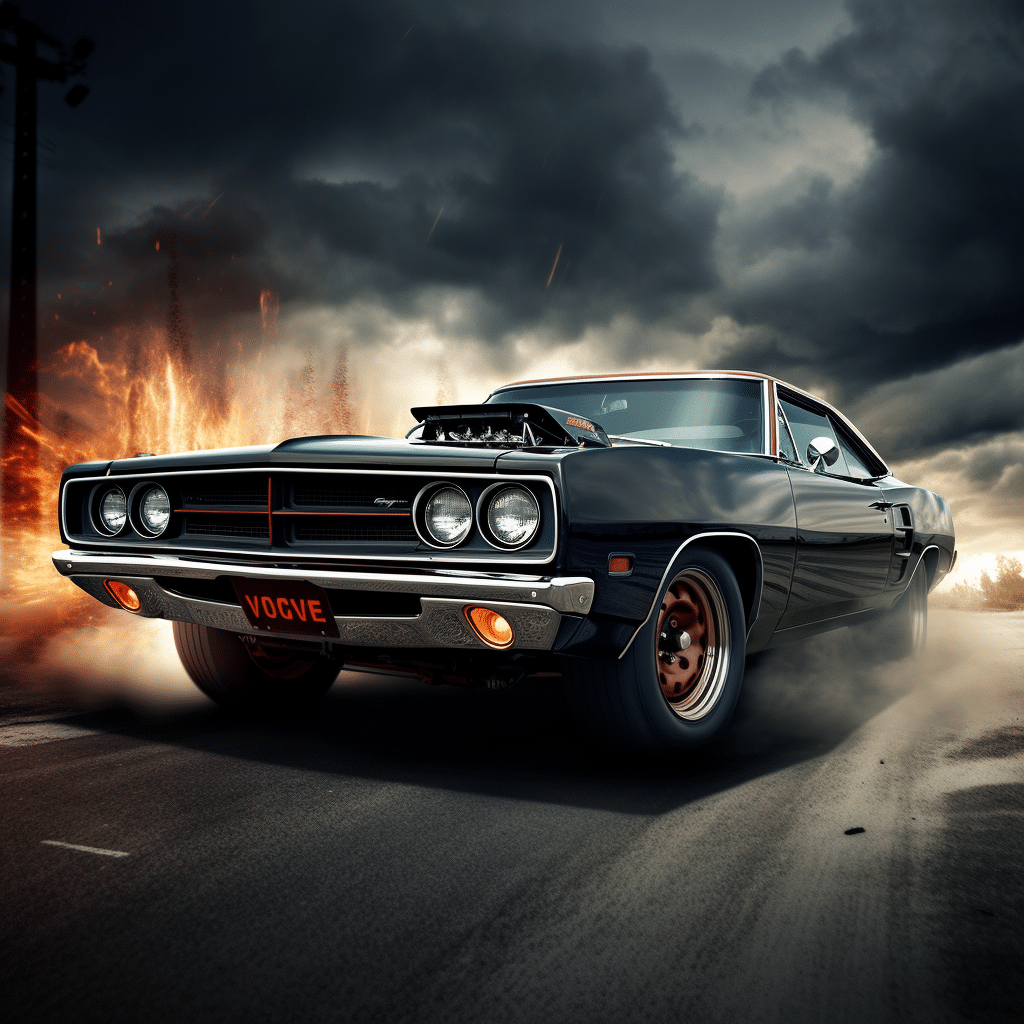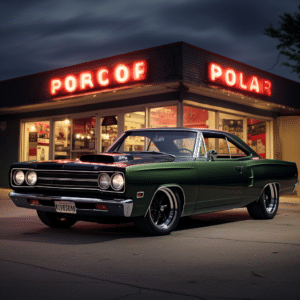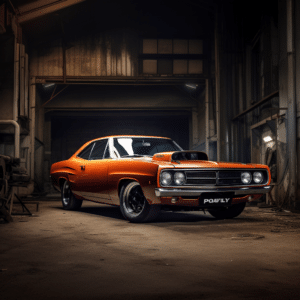
Plymouth Muscle Cars: Power
Introduction to Plymouth Muscle Cars

Plymouth Muscle Cars have captivated car aficionados around the globe. These beasts of power embody the American spirit, combining mighty force with iconic styling. And with their roaring motors and sleek curves, they’ve become a symbol of automotive greatness.
The story of Plymouth Muscle Cars began in the 1960s, when they took to the drag strips and race tracks as fierce contenders. The iconic Barracuda and Road Runner were some of the first models to establish Plymouth’s name in high-performance vehicles. With their monstrous engines, they left their opponents in the dust!
Plymouth Muscle Cars stand out for their one-of-a-kind aesthetics. From the fierce front grilles, to the bold stripes down their sides, these cars have an unmistakable presence on the road. The detail in their design is what sets them apart from other muscle cars of their time.
These legendary rides still hold a special place in automotive history. Fun fact: In 1997, Chrysler Corporation even brought back the brand with the Prowler model, paying respect to its long history.
So…ready to fire up those engines? Then prepare yourself for a wild ride through the exciting history of Plymouth Muscle Cars – a thrill for auto-lovers and a warning for pedestrians!
The History of Plymouth Muscle Cars
The iconic Plymouth Muscle are a reflection of American automotive engineering brilliance. Let’s take a wild ride through the history of these legendary vehicles and their unique details! We’ll start with the Barracuda, introduced in ’64, as the first of its kind. The 1968 Road Runner was an instant hit for its performance and affordability. Then came the 1970 Superbird, a NASCAR racer with groundbreaking aerodynamic features. The 1971 GTX was the luxurious muscle car that combined high power with stylish design.
Did you know the Superbird had a pointy nose cone and huge rear wing? These features were borrowed from Richard Petty’s race car to boost speed on the track.
Indeed, the Plymouth Muscle Cars have been around for decades and still give enthusiasts around the world a thrill. Rev your engines and get ready to experience the timeless appeal of classic muscle cars!
Iconic Plymouth Muscle Car Models
Plymouth Muscle Car Models are renowned for their legendary status in the automotive world. Their powerful performance and unique design have made them popular with car enthusiasts worldwide. Here are five essential features of these Iconic Plymouth Muscle Cars:
- Plymouth Road Runner – Known for its amazing speed and affordability. Its “Beep Beep” horn and V8 engine made it a classic.
- Plymouth Barracuda – With its sleek looks and exceptional power, it was one of the first pony cars to dominate the market.
- Plymouth GTX – The perfect combination of luxury and strength. Its exquisite interior paired with a powerful engine created an unforgettable driving experience.
- Plymouth Superbird – Famous for its aerodynamic design and huge rear wing, it pushed boundaries in speed and style.
- Plymouth ‘Cuda – One of the most sought-after muscle cars. Its HEMI engine made it a true force of nature.
In addition, Plymouth Muscle Cars introduced revolutionary features like disc brakes, hood scoops, and improved suspension systems. To truly understand these iconic vehicles, explore their rich history through documentaries, books, or attend classic car exhibitions. Get ready to feel the power and experience the swagger of Plymouth Muscle Cars – they will have you revving your engine and asking for a black leather jacket!
Characteristics of Plymouth Muscle Cars
Plymouth Muscle Cars stand out from other vehicles with distinct features that make them legendary. These cars boast incredible raw power, bold designs, superior handling, iconic sound, and a racing heritage.
Their impressive horsepower is provided by high-performance engines for remarkable speed and torque. Muscular body lines, bold front grilles, and striking paint jobs give these cars an aggressive look. Precise steering, responsive suspension systems, and advanced braking technology provide an exhilarating driving experience.
The deep rumble of their engine creates a unique symphony that captures attention. Also, they include innovative technologies such as traction control systems, advanced infotainment options, and enhanced safety features.
A ’71 Plymouth ‘Cuda was found tucked away in a barn and after months of restoration work, it was brought back to its former glory. A Collecting and restoring Plymouth Muscle Cars brings joy to car enthusiasts as they turn rust into horsepower, one bolt at a time.
Collecting and Restoring Plymouth Muscle Cars
Collecting and restoring Muscle Cars is a passion shared by many. It’s not just a pastime, but a labour of love needing dedication, patience, and skill.
- 1. Gathering these iconic cars allows people to appreciate the heritage and craftsmanship of the Plymouth brand. Each car has its own narrative, with exclusive features representing the era it was made.
- 2. Restoring these muscle cars is a type of art. It needs careful attention to detail and selecting authentic parts to keep the vehicle true to its original form.
- Lastly, owning and displaying a restored Plymouth Muscle Car is a source of pride for collectors. These cars are more than just objects; they symbolize a piece of automotive history that fascinates young and old.
Though collecting and restoring these cars can be tough, it’s also very fulfilling. The commitment to bring them back to their former glory is admirable and motivating.
Take for example, one collector who found a neglected Plymouth Muscle Car in an old barn. Despite its dilapidated state, he spotted potential in the corroded metal and worn-out interior. Hours of hard work and persistence allowed him to convert this forgotten beauty into a show-stopper. When he switched on the engine for the first time, his joy was indescribable – a sign of his unswerving passion for these extraordinary automobiles.
Legacy and Influence of Plymouth Muscle Cars: These cool cats turned heads and left envy-filled skid marks on the pavement.
Legacy and Influence of Plymouth Muscle Cars
Plymouth Muscle Cars boast a unique legacy and undeniable influence on the auto industry. These iconic rides have left an imprint on enthusiasts and still ignite passion in car-lovers around the world. Let’s delve into the legacy of Plymouth Muscle Cars through this comprehensive table:
| Model | Generation | Years Produced |
|---|---|---|
| Barracuda | First Generation | 1964-1966 |
| Road Runner | Second Generation | 1968-1970 |
| Superbird | Second Generation | 1970 |
| Cuda | Third Generation | 1970-1974 |
This table shows some key models from various generations of Plymouth Muscle Cars, and the years they were produced. Each model has its own characteristics that have helped shape the muscle-car culture.
Plus, Plymouth debuted features like rear spoilers, advanced aerodynamics, and powerful engines to up speed and performance. These innovations pushed boundaries and served as a model for other makers.
Pro Tip: When buying a Muscle Car, check its originality. This includes matching numbers engine and body components. Original cars with proper documentation are highly valued by collectors.
Conclusion: Celebrating the Legacy of Muscle Cars – These beastly beauties prove that horsepower isn’t just for horses, but for nostalgia-filled thrill-seekers.
Conclusion:
Celebrating the Legacy of Plymouth Muscle Cars

The legacy of Plymouth Muscle Cars is one of power, performance, and iconic design. These cars have become iconic. From the legendary Road Runner to the fierce Barracuda, they have enthralled enthusiasts for decades.
These cars are famous for their body styles, curves, and roaring exhausts. Collectors and car lovers seek after them. They have an aggressive stance and made people take notice.
Plus, these vehicles were made for racing. They dominated drag strips and stock car races. This only increased their reputation as performance machines.
Plymouth was an American auto brand, made by Chrysler Corporation from 1928 to 2001. While they made many models, it’s their muscle cars that people remember.
